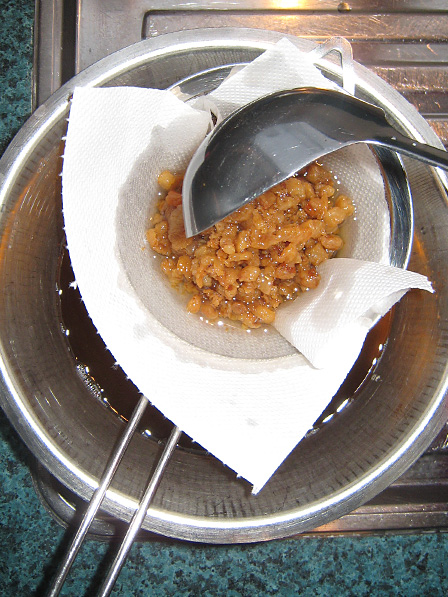Hello out there! I got swept away from updating our beloved website for a while. . . by life and all its demands. I’ve missed writing Farmlet posts! It feels like high time to be getting back to writing regular updates again.
I’m breaking my long silence with a few words about something very dear to my heart: lard.
We were lucky enough to find a source of local free-range pork fat. Finally! I was actually given this precious fat for free because nobody else wants it. The farmer told me he doesn’t kill many fat pigs any more, except for the occasional older sow. He and his wife now aim to breed and raise lean animals, which are preferred by the “health conscious consumer.” This is a sad state of affairs for those of us who recognise lard as a delicious, nourishing and healthy food.
 Straining the lard
Straining the lard
I decided to try rendering batches of lard three different ways: stovetop, oven, and slow cooker. The slow cooker (crock pot) got the thumbs down. My usually-reliable recipe book claimed that much of the fat would have liquefied after 4 to 5 hours on low heat in the slow cooker. I left it for three times this long and still felt that I was wasting too much of the fat due to incomplete rendering. Both the stovetop and oven methods worked well, though.
How to render lard
I used about 2kg of pork fat for each batch (belly fat is especially good), cut into small pieces.
Put it in a large enameled cast iron casserole (any heavy-bottomed pot or casserole with a lid will do) with about 1/4 cup of water.
Add an onion and a handful of herbs if you want to give your lard some extra savoury flavour. We rendered some of our lard with onion and herbs and kept some plain.
Heat the casserole on the stove (over medium heat) until the fat is cooking nicely. Then turn the stove down very low or transfer to an oven preheated to about 140 centigrade.
Cook for about 4 hours, or until most of the fat has turned to liquid.
Strain the lard and cool it a little before pouring it into glass jars. I warm the jars before pouring in the lard, so that they don’t crack from the heat of the hot fat.
Let the lard cool to room temperature before storing it in the fridge or freezer. Lard should keep for a few months in the fridge, and will stay good for over a year in the freezer.
Please be very careful handling the hot fat!









